Social Science Survey Assignment 2022
VerifiedAdded on 2022/10/11
|7
|2334
|12
Assignment
AI Summary
Contribute Materials
Your contribution can guide someone’s learning journey. Share your
documents today.
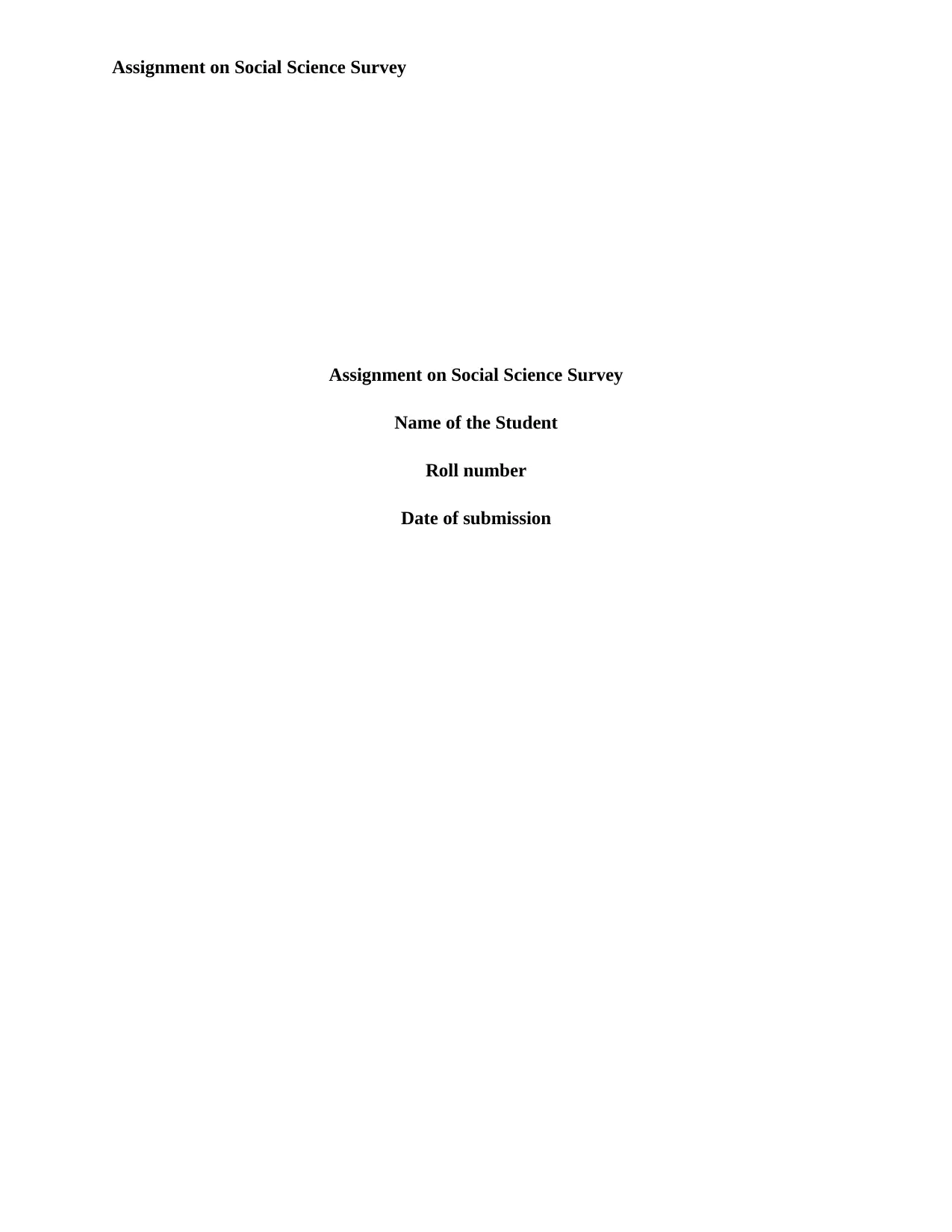
Assignment on Social Science Survey
Assignment on Social Science Survey
Name of the Student
Roll number
Date of submission
Assignment on Social Science Survey
Name of the Student
Roll number
Date of submission
Secure Best Marks with AI Grader
Need help grading? Try our AI Grader for instant feedback on your assignments.
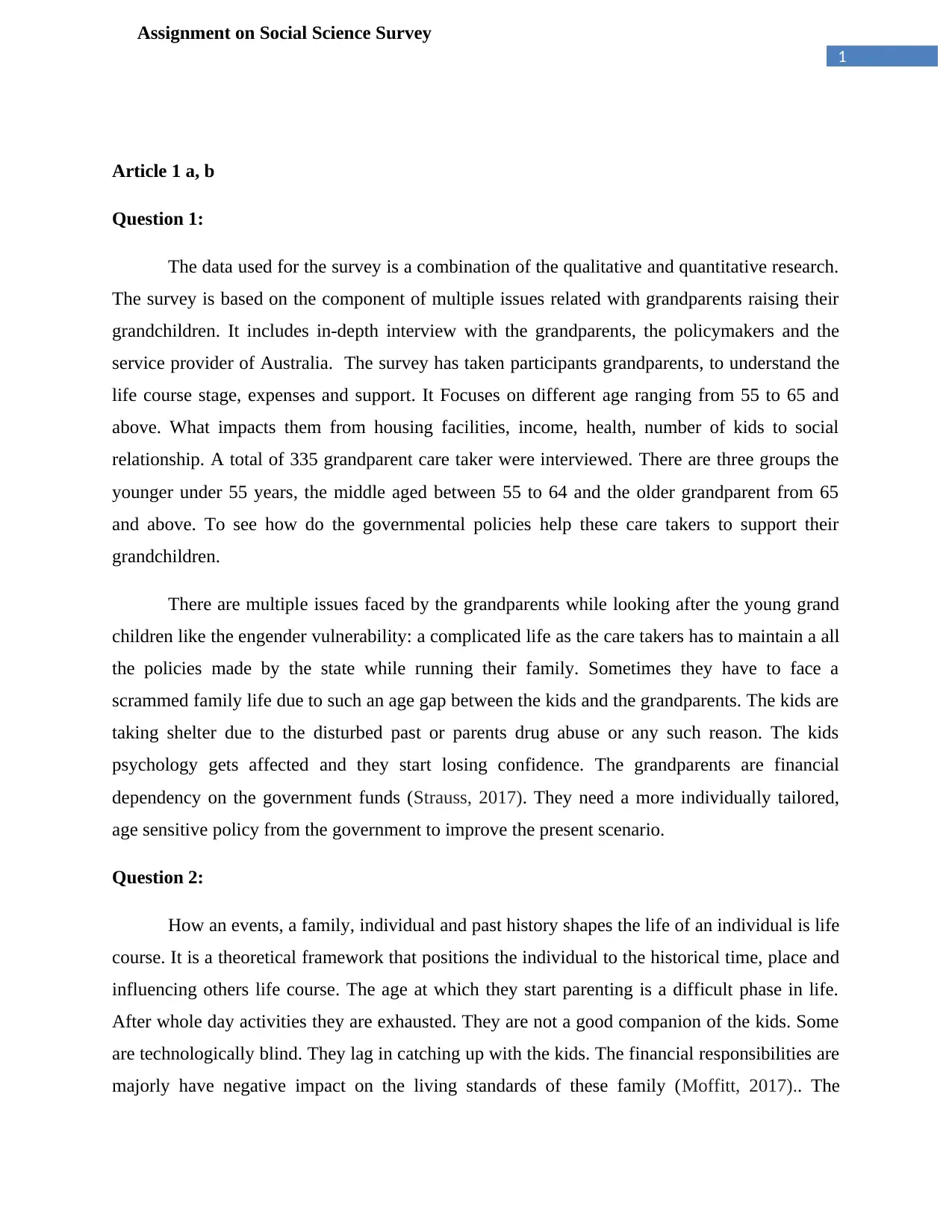
1
Assignment on Social Science Survey
Article 1 a, b
Question 1:
The data used for the survey is a combination of the qualitative and quantitative research.
The survey is based on the component of multiple issues related with grandparents raising their
grandchildren. It includes in-depth interview with the grandparents, the policymakers and the
service provider of Australia. The survey has taken participants grandparents, to understand the
life course stage, expenses and support. It Focuses on different age ranging from 55 to 65 and
above. What impacts them from housing facilities, income, health, number of kids to social
relationship. A total of 335 grandparent care taker were interviewed. There are three groups the
younger under 55 years, the middle aged between 55 to 64 and the older grandparent from 65
and above. To see how do the governmental policies help these care takers to support their
grandchildren.
There are multiple issues faced by the grandparents while looking after the young grand
children like the engender vulnerability: a complicated life as the care takers has to maintain a all
the policies made by the state while running their family. Sometimes they have to face a
scrammed family life due to such an age gap between the kids and the grandparents. The kids are
taking shelter due to the disturbed past or parents drug abuse or any such reason. The kids
psychology gets affected and they start losing confidence. The grandparents are financial
dependency on the government funds (Strauss, 2017). They need a more individually tailored,
age sensitive policy from the government to improve the present scenario.
Question 2:
How an events, a family, individual and past history shapes the life of an individual is life
course. It is a theoretical framework that positions the individual to the historical time, place and
influencing others life course. The age at which they start parenting is a difficult phase in life.
After whole day activities they are exhausted. They are not a good companion of the kids. Some
are technologically blind. They lag in catching up with the kids. The financial responsibilities are
majorly have negative impact on the living standards of these family (Moffitt, 2017).. The
Assignment on Social Science Survey
Article 1 a, b
Question 1:
The data used for the survey is a combination of the qualitative and quantitative research.
The survey is based on the component of multiple issues related with grandparents raising their
grandchildren. It includes in-depth interview with the grandparents, the policymakers and the
service provider of Australia. The survey has taken participants grandparents, to understand the
life course stage, expenses and support. It Focuses on different age ranging from 55 to 65 and
above. What impacts them from housing facilities, income, health, number of kids to social
relationship. A total of 335 grandparent care taker were interviewed. There are three groups the
younger under 55 years, the middle aged between 55 to 64 and the older grandparent from 65
and above. To see how do the governmental policies help these care takers to support their
grandchildren.
There are multiple issues faced by the grandparents while looking after the young grand
children like the engender vulnerability: a complicated life as the care takers has to maintain a all
the policies made by the state while running their family. Sometimes they have to face a
scrammed family life due to such an age gap between the kids and the grandparents. The kids are
taking shelter due to the disturbed past or parents drug abuse or any such reason. The kids
psychology gets affected and they start losing confidence. The grandparents are financial
dependency on the government funds (Strauss, 2017). They need a more individually tailored,
age sensitive policy from the government to improve the present scenario.
Question 2:
How an events, a family, individual and past history shapes the life of an individual is life
course. It is a theoretical framework that positions the individual to the historical time, place and
influencing others life course. The age at which they start parenting is a difficult phase in life.
After whole day activities they are exhausted. They are not a good companion of the kids. Some
are technologically blind. They lag in catching up with the kids. The financial responsibilities are
majorly have negative impact on the living standards of these family (Moffitt, 2017).. The

2
Assignment on Social Science Survey
mortgage for the home, the employment issues due to increased responsibilities. The aging also
impacts health and thus bending the life course towards a more difficult phase.
The survey was done by taking interview from the 335 grandparents. The survey did an
in-depth study of the grandparents raising their grandchildren. The quantitative analysis of ABS
data along with the interviews of grandparent carer was taken. All the factors mentioned above
was considered.
The result was represented in the form of graph to present a better picture of the case
study. Data from the surveys were fed in the spreadsheet and analysed using SPSS and thematic
content analysis for accurate result. There was a mixture of participants ranging from male to
female. The analysis showed that age and life course is associated with grandparents all the
circumstances. The age difference, socio economic gap are major factors that compel the change
in the grandparents. It is shown that the younger parents are less dependent on the governmental
fund. The grandparent always tries to make changes in their in employment, housing, health and
social relationships in association with the comfort of their grand children.
Question 3:
The survey was good all the factors that are responsible for the life course change was
taken into consideration. They used spss to understand the data better. All the results were
represented in the graphical form. This itself make the finding clear to study. I would like to add
that they should have survey more of the individuals. The survey was limited to only 335
grandparents. The survey should include question where we could understand how far the real
parents supporting the children. The survey should also include the children to understand that
they also feel the same as their grandparents feel. Are they happy or not or what changes they
want from the government. A survey is done in limited sample and this survey had both the
qualitative methodology as well as the quantitative methodology to prove its findings (Stavrova
& Ehlebracht, 2016). They survey should have been done in a span of 3 months t see the change.
One after the governments reformation and the other some years a later to understand the impact
of the change.
Question 4:
Assignment on Social Science Survey
mortgage for the home, the employment issues due to increased responsibilities. The aging also
impacts health and thus bending the life course towards a more difficult phase.
The survey was done by taking interview from the 335 grandparents. The survey did an
in-depth study of the grandparents raising their grandchildren. The quantitative analysis of ABS
data along with the interviews of grandparent carer was taken. All the factors mentioned above
was considered.
The result was represented in the form of graph to present a better picture of the case
study. Data from the surveys were fed in the spreadsheet and analysed using SPSS and thematic
content analysis for accurate result. There was a mixture of participants ranging from male to
female. The analysis showed that age and life course is associated with grandparents all the
circumstances. The age difference, socio economic gap are major factors that compel the change
in the grandparents. It is shown that the younger parents are less dependent on the governmental
fund. The grandparent always tries to make changes in their in employment, housing, health and
social relationships in association with the comfort of their grand children.
Question 3:
The survey was good all the factors that are responsible for the life course change was
taken into consideration. They used spss to understand the data better. All the results were
represented in the graphical form. This itself make the finding clear to study. I would like to add
that they should have survey more of the individuals. The survey was limited to only 335
grandparents. The survey should include question where we could understand how far the real
parents supporting the children. The survey should also include the children to understand that
they also feel the same as their grandparents feel. Are they happy or not or what changes they
want from the government. A survey is done in limited sample and this survey had both the
qualitative methodology as well as the quantitative methodology to prove its findings (Stavrova
& Ehlebracht, 2016). They survey should have been done in a span of 3 months t see the change.
One after the governments reformation and the other some years a later to understand the impact
of the change.
Question 4:
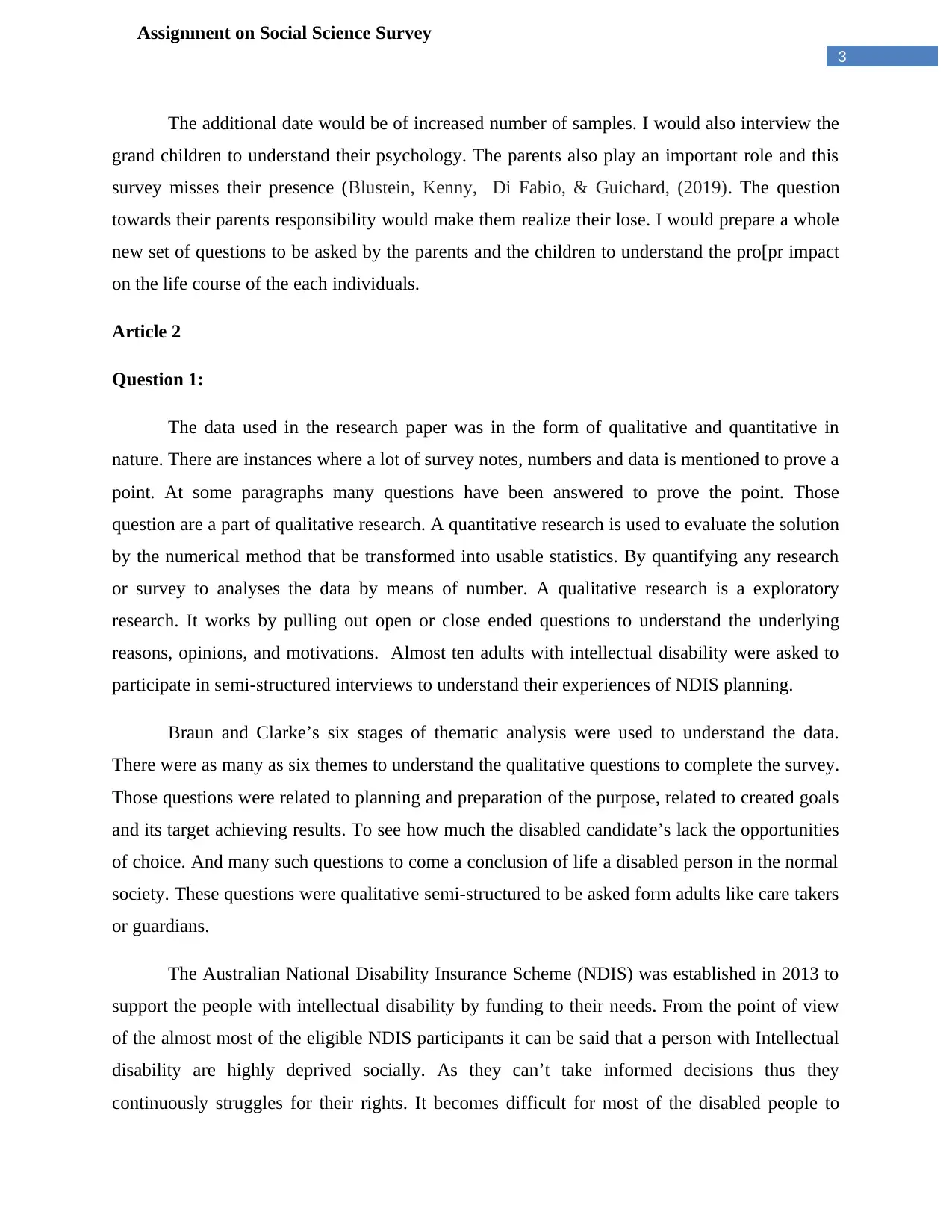
3
Assignment on Social Science Survey
The additional date would be of increased number of samples. I would also interview the
grand children to understand their psychology. The parents also play an important role and this
survey misses their presence (Blustein, Kenny, Di Fabio, & Guichard, (2019). The question
towards their parents responsibility would make them realize their lose. I would prepare a whole
new set of questions to be asked by the parents and the children to understand the pro[pr impact
on the life course of the each individuals.
Article 2
Question 1:
The data used in the research paper was in the form of qualitative and quantitative in
nature. There are instances where a lot of survey notes, numbers and data is mentioned to prove a
point. At some paragraphs many questions have been answered to prove the point. Those
question are a part of qualitative research. A quantitative research is used to evaluate the solution
by the numerical method that be transformed into usable statistics. By quantifying any research
or survey to analyses the data by means of number. A qualitative research is a exploratory
research. It works by pulling out open or close ended questions to understand the underlying
reasons, opinions, and motivations. Almost ten adults with intellectual disability were asked to
participate in semi-structured interviews to understand their experiences of NDIS planning.
Braun and Clarke’s six stages of thematic analysis were used to understand the data.
There were as many as six themes to understand the qualitative questions to complete the survey.
Those questions were related to planning and preparation of the purpose, related to created goals
and its target achieving results. To see how much the disabled candidate’s lack the opportunities
of choice. And many such questions to come a conclusion of life a disabled person in the normal
society. These questions were qualitative semi-structured to be asked form adults like care takers
or guardians.
The Australian National Disability Insurance Scheme (NDIS) was established in 2013 to
support the people with intellectual disability by funding to their needs. From the point of view
of the almost most of the eligible NDIS participants it can be said that a person with Intellectual
disability are highly deprived socially. As they can’t take informed decisions thus they
continuously struggles for their rights. It becomes difficult for most of the disabled people to
Assignment on Social Science Survey
The additional date would be of increased number of samples. I would also interview the
grand children to understand their psychology. The parents also play an important role and this
survey misses their presence (Blustein, Kenny, Di Fabio, & Guichard, (2019). The question
towards their parents responsibility would make them realize their lose. I would prepare a whole
new set of questions to be asked by the parents and the children to understand the pro[pr impact
on the life course of the each individuals.
Article 2
Question 1:
The data used in the research paper was in the form of qualitative and quantitative in
nature. There are instances where a lot of survey notes, numbers and data is mentioned to prove a
point. At some paragraphs many questions have been answered to prove the point. Those
question are a part of qualitative research. A quantitative research is used to evaluate the solution
by the numerical method that be transformed into usable statistics. By quantifying any research
or survey to analyses the data by means of number. A qualitative research is a exploratory
research. It works by pulling out open or close ended questions to understand the underlying
reasons, opinions, and motivations. Almost ten adults with intellectual disability were asked to
participate in semi-structured interviews to understand their experiences of NDIS planning.
Braun and Clarke’s six stages of thematic analysis were used to understand the data.
There were as many as six themes to understand the qualitative questions to complete the survey.
Those questions were related to planning and preparation of the purpose, related to created goals
and its target achieving results. To see how much the disabled candidate’s lack the opportunities
of choice. And many such questions to come a conclusion of life a disabled person in the normal
society. These questions were qualitative semi-structured to be asked form adults like care takers
or guardians.
The Australian National Disability Insurance Scheme (NDIS) was established in 2013 to
support the people with intellectual disability by funding to their needs. From the point of view
of the almost most of the eligible NDIS participants it can be said that a person with Intellectual
disability are highly deprived socially. As they can’t take informed decisions thus they
continuously struggles for their rights. It becomes difficult for most of the disabled people to
Paraphrase This Document
Need a fresh take? Get an instant paraphrase of this document with our AI Paraphraser
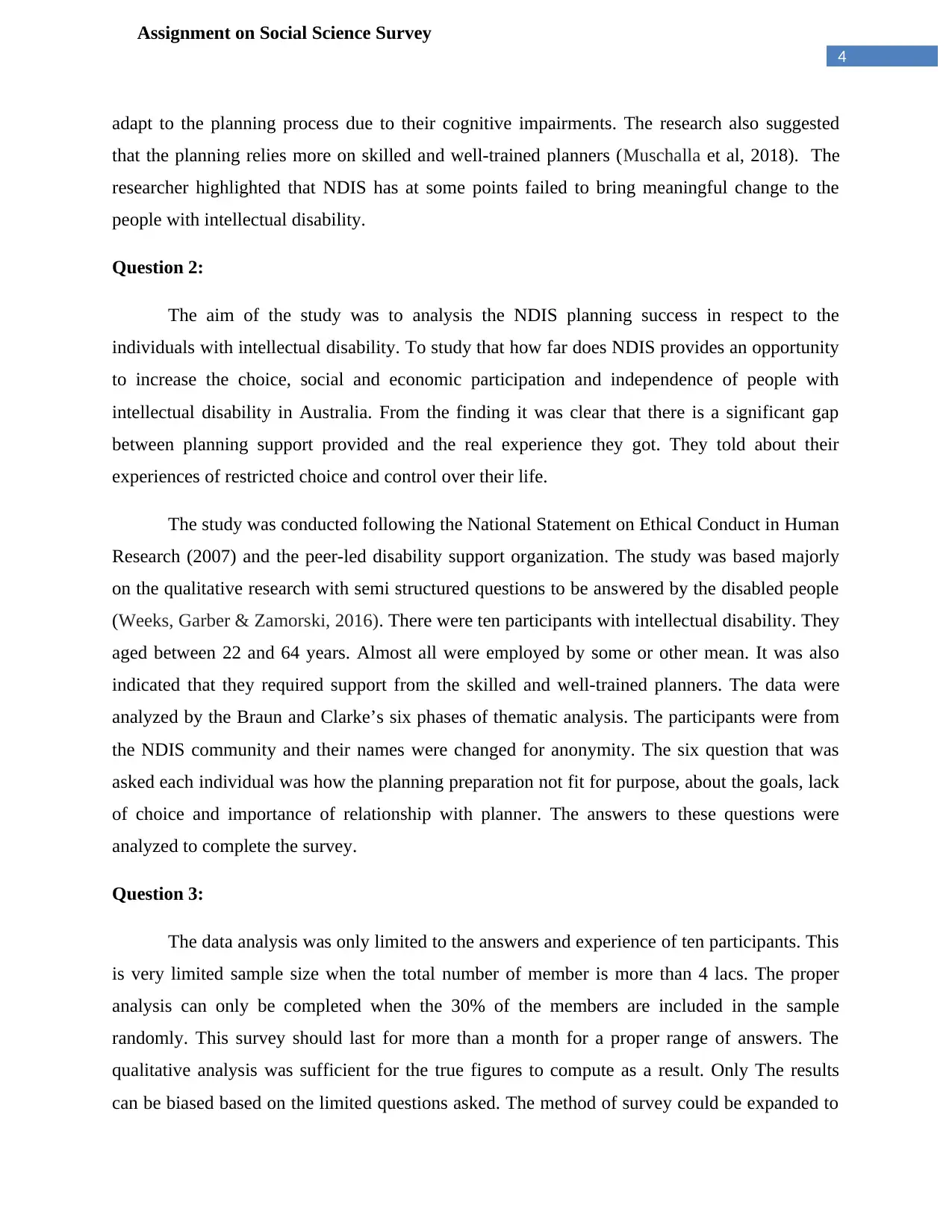
4
Assignment on Social Science Survey
adapt to the planning process due to their cognitive impairments. The research also suggested
that the planning relies more on skilled and well-trained planners (Muschalla et al, 2018). The
researcher highlighted that NDIS has at some points failed to bring meaningful change to the
people with intellectual disability.
Question 2:
The aim of the study was to analysis the NDIS planning success in respect to the
individuals with intellectual disability. To study that how far does NDIS provides an opportunity
to increase the choice, social and economic participation and independence of people with
intellectual disability in Australia. From the finding it was clear that there is a significant gap
between planning support provided and the real experience they got. They told about their
experiences of restricted choice and control over their life.
The study was conducted following the National Statement on Ethical Conduct in Human
Research (2007) and the peer-led disability support organization. The study was based majorly
on the qualitative research with semi structured questions to be answered by the disabled people
(Weeks, Garber & Zamorski, 2016). There were ten participants with intellectual disability. They
aged between 22 and 64 years. Almost all were employed by some or other mean. It was also
indicated that they required support from the skilled and well-trained planners. The data were
analyzed by the Braun and Clarke’s six phases of thematic analysis. The participants were from
the NDIS community and their names were changed for anonymity. The six question that was
asked each individual was how the planning preparation not fit for purpose, about the goals, lack
of choice and importance of relationship with planner. The answers to these questions were
analyzed to complete the survey.
Question 3:
The data analysis was only limited to the answers and experience of ten participants. This
is very limited sample size when the total number of member is more than 4 lacs. The proper
analysis can only be completed when the 30% of the members are included in the sample
randomly. This survey should last for more than a month for a proper range of answers. The
qualitative analysis was sufficient for the true figures to compute as a result. Only The results
can be biased based on the limited questions asked. The method of survey could be expanded to
Assignment on Social Science Survey
adapt to the planning process due to their cognitive impairments. The research also suggested
that the planning relies more on skilled and well-trained planners (Muschalla et al, 2018). The
researcher highlighted that NDIS has at some points failed to bring meaningful change to the
people with intellectual disability.
Question 2:
The aim of the study was to analysis the NDIS planning success in respect to the
individuals with intellectual disability. To study that how far does NDIS provides an opportunity
to increase the choice, social and economic participation and independence of people with
intellectual disability in Australia. From the finding it was clear that there is a significant gap
between planning support provided and the real experience they got. They told about their
experiences of restricted choice and control over their life.
The study was conducted following the National Statement on Ethical Conduct in Human
Research (2007) and the peer-led disability support organization. The study was based majorly
on the qualitative research with semi structured questions to be answered by the disabled people
(Weeks, Garber & Zamorski, 2016). There were ten participants with intellectual disability. They
aged between 22 and 64 years. Almost all were employed by some or other mean. It was also
indicated that they required support from the skilled and well-trained planners. The data were
analyzed by the Braun and Clarke’s six phases of thematic analysis. The participants were from
the NDIS community and their names were changed for anonymity. The six question that was
asked each individual was how the planning preparation not fit for purpose, about the goals, lack
of choice and importance of relationship with planner. The answers to these questions were
analyzed to complete the survey.
Question 3:
The data analysis was only limited to the answers and experience of ten participants. This
is very limited sample size when the total number of member is more than 4 lacs. The proper
analysis can only be completed when the 30% of the members are included in the sample
randomly. This survey should last for more than a month for a proper range of answers. The
qualitative analysis was sufficient for the true figures to compute as a result. Only The results
can be biased based on the limited questions asked. The method of survey could be expanded to
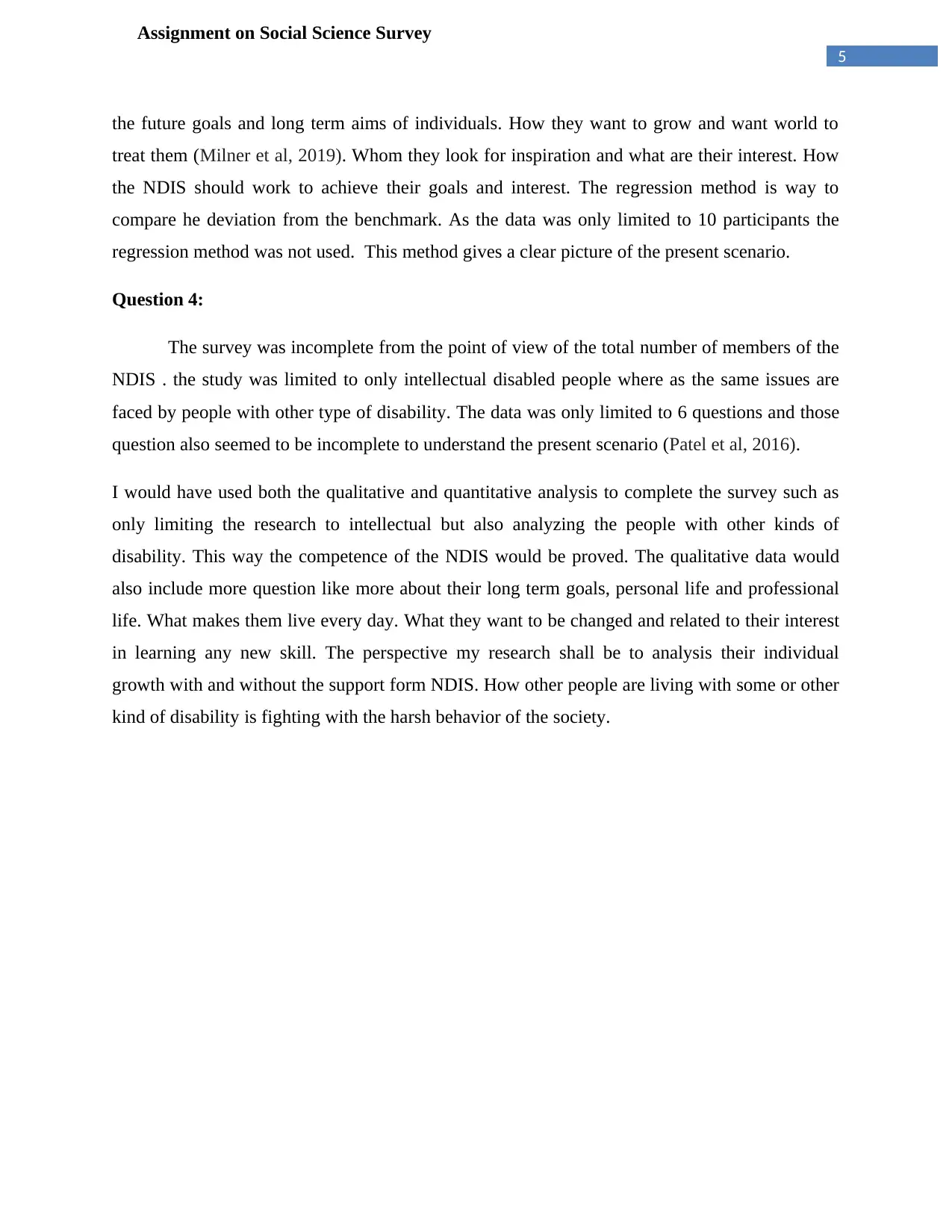
5
Assignment on Social Science Survey
the future goals and long term aims of individuals. How they want to grow and want world to
treat them (Milner et al, 2019). Whom they look for inspiration and what are their interest. How
the NDIS should work to achieve their goals and interest. The regression method is way to
compare he deviation from the benchmark. As the data was only limited to 10 participants the
regression method was not used. This method gives a clear picture of the present scenario.
Question 4:
The survey was incomplete from the point of view of the total number of members of the
NDIS . the study was limited to only intellectual disabled people where as the same issues are
faced by people with other type of disability. The data was only limited to 6 questions and those
question also seemed to be incomplete to understand the present scenario (Patel et al, 2016).
I would have used both the qualitative and quantitative analysis to complete the survey such as
only limiting the research to intellectual but also analyzing the people with other kinds of
disability. This way the competence of the NDIS would be proved. The qualitative data would
also include more question like more about their long term goals, personal life and professional
life. What makes them live every day. What they want to be changed and related to their interest
in learning any new skill. The perspective my research shall be to analysis their individual
growth with and without the support form NDIS. How other people are living with some or other
kind of disability is fighting with the harsh behavior of the society.
Assignment on Social Science Survey
the future goals and long term aims of individuals. How they want to grow and want world to
treat them (Milner et al, 2019). Whom they look for inspiration and what are their interest. How
the NDIS should work to achieve their goals and interest. The regression method is way to
compare he deviation from the benchmark. As the data was only limited to 10 participants the
regression method was not used. This method gives a clear picture of the present scenario.
Question 4:
The survey was incomplete from the point of view of the total number of members of the
NDIS . the study was limited to only intellectual disabled people where as the same issues are
faced by people with other type of disability. The data was only limited to 6 questions and those
question also seemed to be incomplete to understand the present scenario (Patel et al, 2016).
I would have used both the qualitative and quantitative analysis to complete the survey such as
only limiting the research to intellectual but also analyzing the people with other kinds of
disability. This way the competence of the NDIS would be proved. The qualitative data would
also include more question like more about their long term goals, personal life and professional
life. What makes them live every day. What they want to be changed and related to their interest
in learning any new skill. The perspective my research shall be to analysis their individual
growth with and without the support form NDIS. How other people are living with some or other
kind of disability is fighting with the harsh behavior of the society.
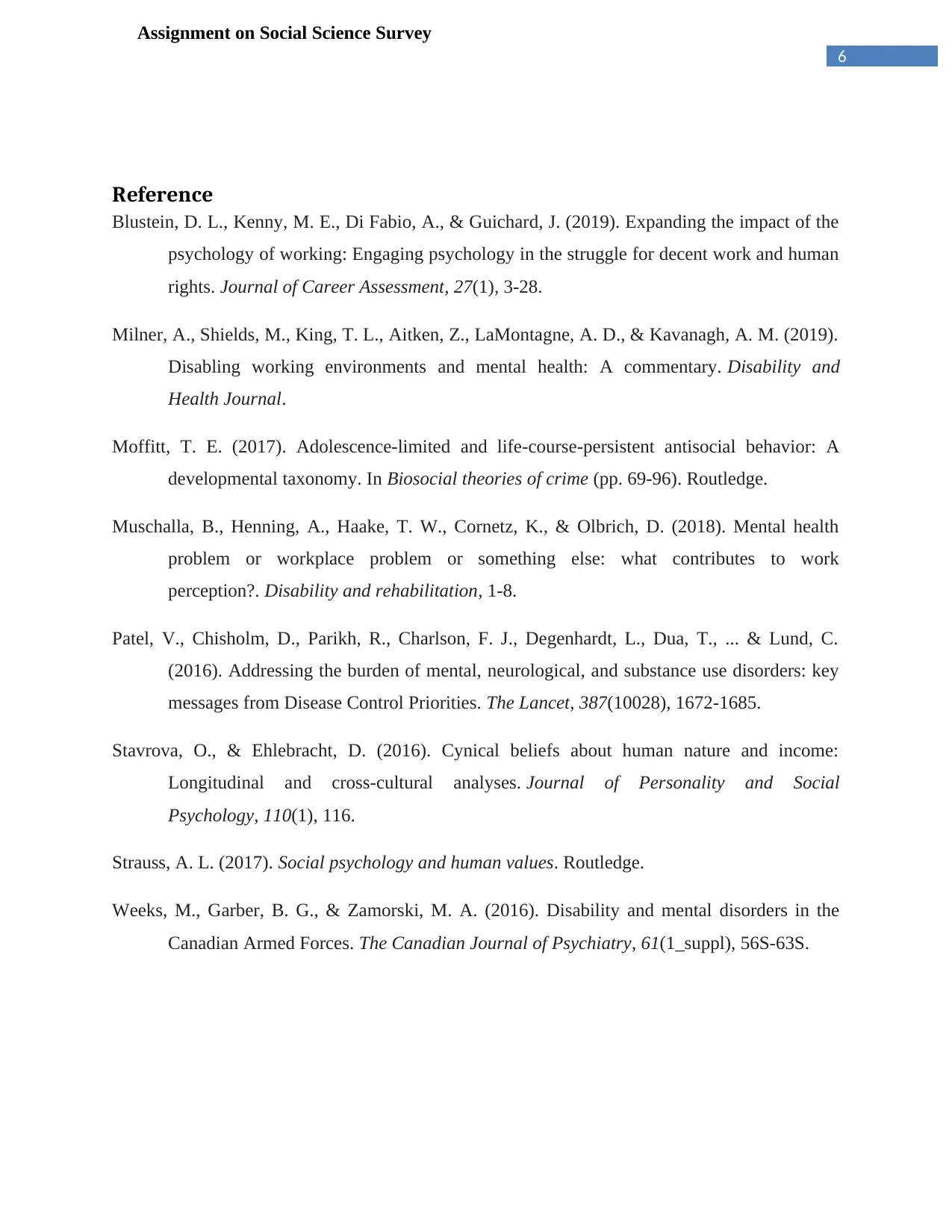
6
Assignment on Social Science Survey
Reference
Blustein, D. L., Kenny, M. E., Di Fabio, A., & Guichard, J. (2019). Expanding the impact of the
psychology of working: Engaging psychology in the struggle for decent work and human
rights. Journal of Career Assessment, 27(1), 3-28.
Milner, A., Shields, M., King, T. L., Aitken, Z., LaMontagne, A. D., & Kavanagh, A. M. (2019).
Disabling working environments and mental health: A commentary. Disability and
Health Journal.
Moffitt, T. E. (2017). Adolescence-limited and life-course-persistent antisocial behavior: A
developmental taxonomy. In Biosocial theories of crime (pp. 69-96). Routledge.
Muschalla, B., Henning, A., Haake, T. W., Cornetz, K., & Olbrich, D. (2018). Mental health
problem or workplace problem or something else: what contributes to work
perception?. Disability and rehabilitation, 1-8.
Patel, V., Chisholm, D., Parikh, R., Charlson, F. J., Degenhardt, L., Dua, T., ... & Lund, C.
(2016). Addressing the burden of mental, neurological, and substance use disorders: key
messages from Disease Control Priorities. The Lancet, 387(10028), 1672-1685.
Stavrova, O., & Ehlebracht, D. (2016). Cynical beliefs about human nature and income:
Longitudinal and cross-cultural analyses. Journal of Personality and Social
Psychology, 110(1), 116.
Strauss, A. L. (2017). Social psychology and human values. Routledge.
Weeks, M., Garber, B. G., & Zamorski, M. A. (2016). Disability and mental disorders in the
Canadian Armed Forces. The Canadian Journal of Psychiatry, 61(1_suppl), 56S-63S.
Assignment on Social Science Survey
Reference
Blustein, D. L., Kenny, M. E., Di Fabio, A., & Guichard, J. (2019). Expanding the impact of the
psychology of working: Engaging psychology in the struggle for decent work and human
rights. Journal of Career Assessment, 27(1), 3-28.
Milner, A., Shields, M., King, T. L., Aitken, Z., LaMontagne, A. D., & Kavanagh, A. M. (2019).
Disabling working environments and mental health: A commentary. Disability and
Health Journal.
Moffitt, T. E. (2017). Adolescence-limited and life-course-persistent antisocial behavior: A
developmental taxonomy. In Biosocial theories of crime (pp. 69-96). Routledge.
Muschalla, B., Henning, A., Haake, T. W., Cornetz, K., & Olbrich, D. (2018). Mental health
problem or workplace problem or something else: what contributes to work
perception?. Disability and rehabilitation, 1-8.
Patel, V., Chisholm, D., Parikh, R., Charlson, F. J., Degenhardt, L., Dua, T., ... & Lund, C.
(2016). Addressing the burden of mental, neurological, and substance use disorders: key
messages from Disease Control Priorities. The Lancet, 387(10028), 1672-1685.
Stavrova, O., & Ehlebracht, D. (2016). Cynical beliefs about human nature and income:
Longitudinal and cross-cultural analyses. Journal of Personality and Social
Psychology, 110(1), 116.
Strauss, A. L. (2017). Social psychology and human values. Routledge.
Weeks, M., Garber, B. G., & Zamorski, M. A. (2016). Disability and mental disorders in the
Canadian Armed Forces. The Canadian Journal of Psychiatry, 61(1_suppl), 56S-63S.
1 out of 7
![[object Object]](/_next/static/media/star-bottom.7253800d.svg)

